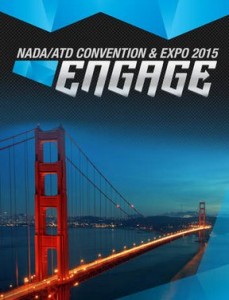 For franchised dealers and their suppliers, attending the National Automobile Dealers Association (NADA) Convention is a must. I attended NADA 2015 on Friday and Saturday with two colleagues from Automotive Digest at the Moscone Center in San Francisco. Here are a few thoughts from my notebook:
For franchised dealers and their suppliers, attending the National Automobile Dealers Association (NADA) Convention is a must. I attended NADA 2015 on Friday and Saturday with two colleagues from Automotive Digest at the Moscone Center in San Francisco. Here are a few thoughts from my notebook:
- The industry seems to be healthy, with attendance at 22,000 to 24,000 people – up from last year and about 550 exhibitors in the three separate Moscone Center halls. As for car sales, NADA’s chief economist Steven Szakaly forecasted US new vehicle sales will go up from 16.5 million sold in 2014 to 16.9 million sold this year. Economic growth is behind it with an improving housing market and job expansion leading to a surge in demand; low gas prices are a factor and that should tip the scale to more demand for pickup trucks and SUVs.
- Michelle Krebs, senior analyst at AutoTrader, expects electric vehicle (EV) sales to continue softening this year. Some of that has to do with internal combustion engines having stronger fuel economy and performance through stop/start systems, direct injection, turbocharging, and other factors. Limitations on EV charging stations are another part of it. As for hybrids, there’s still a lot of online shopper interest in them, but that’s many times diverted over to fuel-efficient vehicle purchases. Krebs was very impressed with the Consumer Electronics Show (CES) this month, where automakers for the first time played the dominant role. CES could be the leading auto show of the future, Krebs said. Mercedes stole the show on driverless cars, and BMW and Volkswagen stood out demonstrating their self-parking car systems. One AutoTrader survey showed that while consumers are not that supportive of self-driving cars, they do have interest in connected car technology features currently available on cars – and which are leading the way toward autonomous vehicles.
- Jennifer Weaver of National Biodiesel Board said that the association’s annual conference this month in Fort Worth, Texas, was well attended. There’s still concern about the US Environmental Protection Agency’s (EPA’s) final ruling on the Renewable Fuel Standard (RFS) being delayed. Biodiesel is the only advanced biofuel on the RFS list of supported fuels that’s reached commercial scale production and sales. Nearly all diesel vehicles allow consumption of biodiesel, with much of that in the B5 to B20 range. While some biodiesel producers were hit hard by the EPA’s delay of its production schedule, there are several large and stable biodiesel companies, Weaver said. Having stringent ASTM fuel specifications has set a standard for bringing clean biodiesel to fueling stations. Fleets are gaining more interest in biodiesel since it reduces greenhouse gas emissions by more than 50% compared to petroleum diesel; the cost is comparable and sometimes less than diesel; you can run biodiesel without having to make any engine conversions; and public fuel dispensers providing biodiesel are becoming widespread throughout the US.
- As for big news breaking at the convention, former Florida Governor Jeb Bush attacked the Consumer Federation Protection Bureau (CFPB) for coming down too hard on dealer sales tactics. Some think Bush is likely to announce his candidacy for president in 2016 – one year after keynote speaker and potential presidential candidate Hillary Clinton gave a keynote speech at the NADA convention. Another hot topic being discussed is what’s going to happen to dealer corporate buyouts and mergers now that Warren Buffett and Berkshire Hathaway have invested their way into the dealer world. Another interesting news development took place during NADA when billionaire investor George Soros, who has a lot of experience in auto industry capitalization, was said to be considering acquiring a dealer network.
- John Krafcik, president of TrueCar, sees a strong correlation between gas prices and Toyota Prius sales, which continue to be down. Full-size pickups are doing much better than hybrids as gas prices stay down. On the subject of clean diesel passenger vehicles, Krafcik sees that greenhouse gas emissions present a strong challenge for diesel vehicles. Diesel vehicles release 14% more CO2 than gasoline; some of these clean diesel cars may be about 10% to 15% more fuel efficient than comparable gasoline engine cars, but they end up breaking even with diesel cars usually costing more than gas engine models.
- Going mobile in San Francisco means accessing transportation alternatives such as riding in a cabled electric bus, or a BART train, or taking Uber across town. I rode with Uber to and from the airport to save money off the usual taxi fare of around $50 from SFO to the center of the city. One of my trips cost $34 and the fee on the return trip to the airport was only $16. Why that was so much cheaper the second time wasn’t explained to me.
- Millennials are getting serious about buying cars. “Millennials, like other generations, see car ownership as a way to establish independence,” Berj Kazanjian, Senior Vice President of MTV’s Ad Sales Research, said about study findings at a presentation during NADA 2015. They “also see car ownership as a way to craft their unique adult identity.” (I would also remind you to keep in mind that several studies in recent years have shown young people have a lot of interest in plug-in electrics, hybrids, and other alternative fuel vehicles. Just make sure you can reach them on their mobile devices.)



